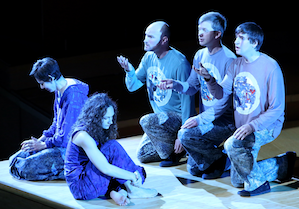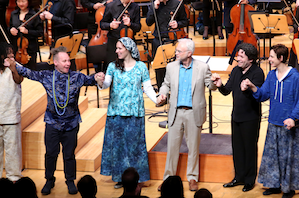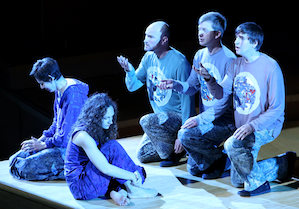
The Gospel According to the Other Mary, composer John Adams’ sixth music drama created in collaboration with stage director Peter Sellars was given its staged premiere by the Los Angeles Philharmonic at Disney Hall on March 7. Music Director Gustavo Dudamel had to fly to Caracas directly after the opening to attend and conduct at the funeral of Venezuela’s President Hugo Chávez. But he was back in time to lead a musically incandescent production on March 10, which was what I saw and heard.
The “Other Mary” is the woman often called (though never here) Mary Magdalen, not to be confused with Mary the mother of Jesus. (Jesus never appears: When his words or presence are required, other people sing or mime them.) Like Adams’ and Sellars’ El Niño, Gospel is more a staged oratorio than an opera. There are only three singers, plus a trio of countertenors (a concept also used in El Niño) who serve as narrators and fill in occasional roles, and a chorus (in casual modern dress), which remains in place above and behind the musicians, although it also does a fair amount of bouncing around.
Of all of Adams’ scores (and I’ve heard all the music dramas in live performances, and most of the other music as well), Gospel (along with A Flowering Tree) is perhaps the most suave, continuous, and instrumentally ingenious. It lacks the powerhouse moments of Nixon in China and Dr. Atomic — although Lazarus’ and Jesus’ resurrections get full trumpets, drums, and chorus — and much of the time is unusually restrained, supporting but never overwhelming the singers, all sections and soloists held in balance by Maestro Dudamel, all entries and silences at pinpoint.
Musical Mastery

In this score, Adams returns to what was best in his early minimalist works — long stretches of rapidly repeated chords and phrases, an ever-pulsing, ever-onward beat, meeting and leading the emotions onstage. But by now he has so mastered the style that he can shift keys, rhythm, instrumentation, and phrases at will, interrupt the flow at any time for eloquent flute calls, trombone blasts, and percussion, or move to singing strings and woodwinds.
The single strongest voice among the performers was that of Russell Thomas, a big, booming tenor who played the reborn Lazarus in Act 2, where he does justice to two poetic solos. (The dying, dead, and resurrected Lazarus in Act 1 was played by Anani Sanouvi, a slim, longhaired African dancer, who had the best moves of anyone onstage.) The two sisters were sung by ardent mezzo-sopranos, Kelley O’Connor (Mary) and Tamara Mumford (Martha), both beautifully. If I preferred the rich, round lower tones of Mumford, it may have been because O’Connor had so much broader and wilder a range of emotions to convey; she is a passionate actress as well as a singer.
The trio of countertenors (Daniel Bubeck, Brian Cummings, and Nathan Medley) all acted as well as they sang. The two male dancers, Sanouvi and Michael Schumaker, could move in Sellars’ classic “music made visible” style, and act complex roles at the same time. Dancer Troy Ogilvie, as Mary’s haunting, evil self, was almost too intense for the stage. And the Los Angeles Master Chorale, asked to do so much more than a chorus is usually expected to do, handled its challenging role with considerable strength.
Of all of Adams’ scores Gospel is perhaps the most suave, continuous, and instrumentally ingenious.
Sellars began inserting other writers’ poetry and prose into his librettos for El Niño and Dr. Atomic, lines that sometimes had nothing to do with the story. But never have his borrowed texts made less apparent sense than in Gospel.
The majority of the lines in Sellars’ libretto come, as one might expect, from the original gospels. Old Testament sources are used as a source of “eternalizing” poetry. But also included are four powerful poems by Louise Erdrich; two at least make reference to the Crucifixion — one as a kind of hysterical nightmare, sung by the chorus. Another seems a response to parental rape. There are also three prose passages by the Catholic pacifist/activist Dorothy Day (1897-1990). One suits the moral confusion of Mary. But the other two (sung by Martha, the social worker) describe the sufferings of the American poor and oppressed of 1942 (with a reference to Churchill), and the time she spent with United Farm Workers’ pickets in California in 1973 (with a reference to César Chavez). I can find no way to relate these or other modern insertions, so alien in tone and style, to the Gospel story of Jesus’ last days, his crucifixion and resurrection, despite Adams’ and Sellars’ efforts to link suffering and violence then with suffering and violence now.
Sellars’ libretto is too often a jumbled pastiche.
Sellars also borrows freely from poets like Primo Levi (Lazarus sings Levi’s ecumenical Passover at the Last Supper), Rubén Dario, and Rosario Castellanos (in Spanish), Hildegarde von Bingen (in Latin), and Adams’ former collaborator June Jordan. The result is too often a jumbled pastiche.
The production was played on a simple two-foot-high wooden platform to the left of the conductor. To his right was a plain pine dining table, for Sellars’ stripped-down version of the Last Supper. The costumes were mostly timeless and blue; hard-working Martha wore a headscarf, her neurotic sister had her hair cut short. The male dancers wore sleeveless blue pajamas, the three countertenors gray sweatshirts. Both the male dancers, and Mary and her aggressive alter-ego dancer, engage in prolonged homoerotic caressing, wrestling and embraces.
The triumph of Adams’ music and the performance it received make me look forward to the recording.

